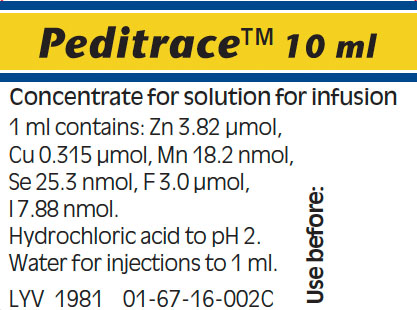PEDITRACE- zinc, copper, manganese, selenium, fluorine, and iodine injection, solution
Fresenius Kabi USA, LLC
Disclaimer: This drug has not been found by FDA to be safe and effective, and this labeling has not been approved by FDA. For further information about unapproved drugs, click here.
----------
Peditrace
1 QUALITATIVE AND QUANTITATIVE
COMPOSITION
1 ml of PEDITRACE contains:
Active ingredients Quantity
Zinc chloride 521 µg
Copper chloride 2H 2O 53.7 µg
Manganese chloride 4H 2O 3.60 µg
Sodium selenite anhydrous 4.38 µg
Sodium fluoride 126 µg
Potassium iodide 1.31 µg
The active ingredients in 1 ml of PEDITRACE correspond to
Zn 250 µg 3.82 µmol
Cu 20 µg 0.315 µmol
Mn 1 µg 18.2 nmol
Se 2 µg 25.3 nmol
F 57 µg 3.00 µmol
I 1 µg 7.88 nmol
The contents of sodium and potassium correspond to
Sodium 70 µg 3.05 µmol
Potassium 0.31 µg 7.88 nmol
For excipients, see 5.1.
PRODUCT PROPERTIES
• Osmolality 38 mosm/kg water
• pH: 2.0
2
PHARMACEUTICAL
FORM
Concentrate for solution for infusion
3
CLINICAL
PARTICULARS
3.1 Therapeutic indications
PEDITRACE is indicated in premature and full-term infants and children needing intravenous nutrition to supply the basal requirements of trace elements.
3.2 Posology and method of administration
PEDITRACE must not be given undiluted.
The recommended dose is 1 ml PEDITRACE/kg body weight/day for infants and children with a weight of up to 15 kg. The basic requirements of trace elements are covered by a daily dose of 15 ml to children weighing more than 15 kg.
3.3 Contraindications
Wilson’s Disease.
3.4 Special warnings and special precautions for use
PEDITRACE should be used with caution in patients with impaired biliary and/or renal function, in whom the excretion of trace elements may be significantly decreased.
PEDITRACE should also be used with caution in patients with biochemical or clinical evidence of liver dysfunction (especially cholestasis).
If the treatment is continued for more than 4 weeks, checking of manganese levels is required.
Patients with increased losses or requiring prolonged intravenous nutrition should be monitored biochemically to confirm the requirements are being met appropriately.
3.5 Interaction with other medicinal products and other forms of interaction
No interactions with other drugs have been observed.
3.6 Pregnancy and lactation
Not applicable.
3.7 Effects on ability to drive and use machines
Not applicable.
3.8 Undesirable effects
No adverse effects related to the trace elements in PEDITRACE have been reported.
Superficial thrombophlebitis has been observed when glucose containing PEDITRACE was given. However, it is not possible to deduce whether this reaction is attributable to the trace elements infusion or not.
Allergic reactions to iodine may occur following topical application. No adverse reactions are known to occur as a consequence of using the recommended intravenous iodide dosage levels.
3.9 Overdose
In patients with impaired renal or biliary function, there is an increased risk for accumulation of trace elements.
4 PHARMACOLOGICAL
PROPERTIES
4.1 Pharmacodynamic properties
PEDITRACE is a mixture of trace elements in amounts normally absorbed from the oral diet and should have no pharmacodynamic effect besides maintaining or repleting nutritional status.
4.2 Pharmacokinetic properties
When infused intravenously the trace elements in PEDITRACE are handled in a similar way to trace elements from an oral diet. Individual trace elements will be taken up by tissues to different extents, depending on the requirement within each tissue to maintain or restore the concentration of each element for the metabolic requirement of that tissue.
Copper and manganese are normally excreted via the bile, whereas selenium and zinc (especially in patients receiving intravenous nutrition) are mainly excreted via the urine.
4.3 Preclinical safety data
The safety evaluation is based mainly on clinical experience and documentation.
5 PHARMACEUTICAL PARTICULARS
5.1 List of excipients
Hydrochloric acid
Water for injections
5.2 Incompatibilities
PEDITRACE may only be added to or mixed with other medicinal products for which compatibility has been documented. See 5.6.
5.3 Shelf‑life
3 years.
5.4 Special precautions for storage
Do not store above 25°C. Do not freeze.
5.5 Nature and content of container
Vial for injection, polypropylene plastic.
Pack size: 10 x 10 ml
5.6 Instructions for use and handling
COMPATIBILITY
Additions should be made aseptically.
Additions
Up to 6 ml PEDITRACE can be added to 100 ml Vaminolact, Vamin 9 Electrolyte Free, Vamin 14 Electrolyte Free or glucose solution (50-500 mg/ml).
INFUSION TIME
The infusion time should not be less than 8 hours. The infusion should be given at a very slow rate.
STABILITY
When additions are made to an infusion solution, the infusion should be completed within 24 hours from preparation to prevent microbiological contamination. The left-over contents of opened bottles/vials/ampoules should be discarded and not kept for later use.
| PEDITRACE
zinc, copper, manganese, selenium, fluorine, and iodine injection, solution |
||||||||||||||||||||||||
|
||||||||||||||||||||||||
|
||||||||||||||||||||||||
|
||||||||||||||||||||||||
|
||||||||||||||||||||||||
|
||||||||||||||||||||||||
| Labeler - Fresenius Kabi USA, LLC (608775388) |
| Establishment | |||
| Name | Address | ID/FEI | Business Operations |
|---|---|---|---|
| Fresenius Kabi Norge AS | 731170932 | manufacture(63323-147) | |

